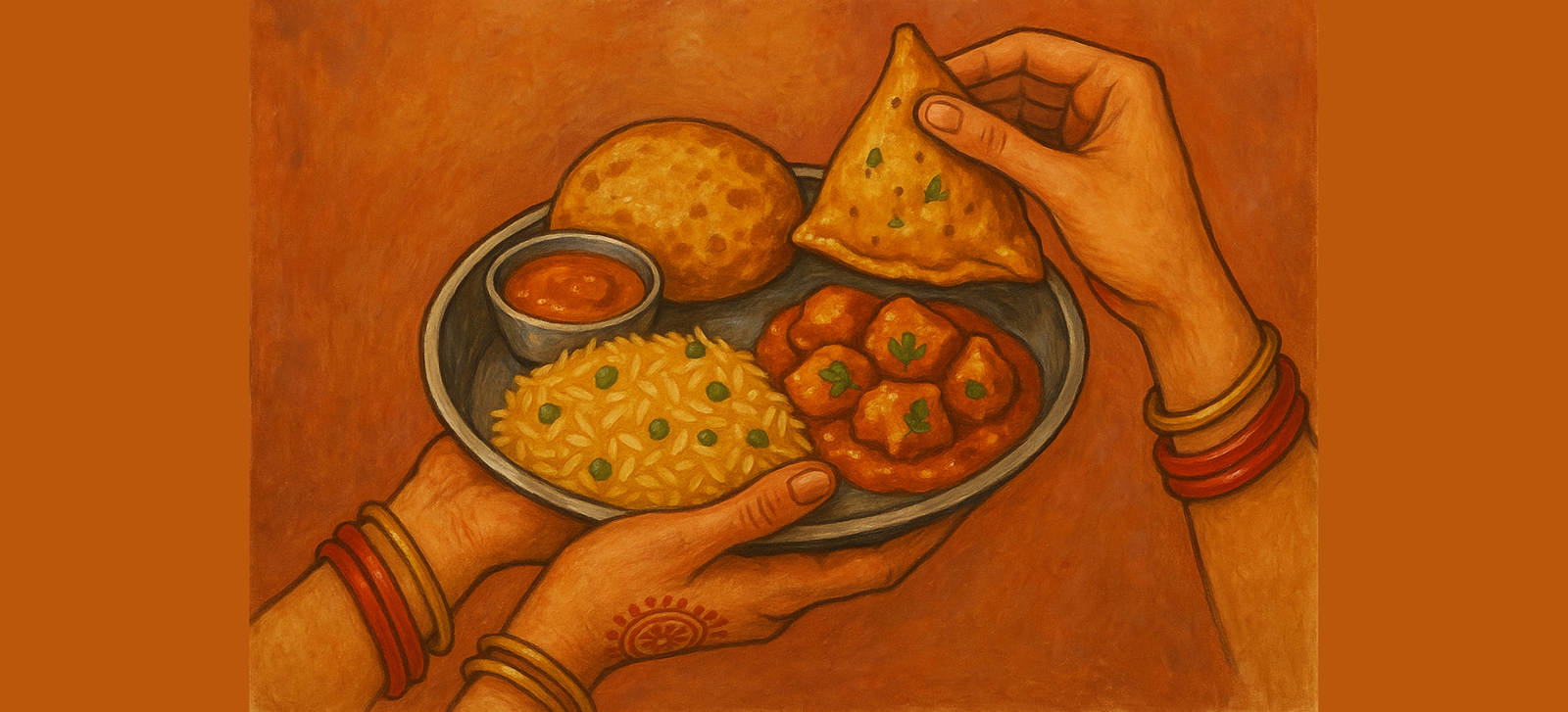The Fork in the Road (Literally)
Picture this: You’re sitting across from your Western colleague at a fancy Mumbai restaurant, watching them struggle with a knife and fork against a perfectly innocent piece of naan. Meanwhile, you’re effortlessly scooping dal with your fingers, and they look at you like you’ve just performed street magic.
“Isn’t that… unhygienic?” they whisper, as if eating with hands might summon the apocalypse.
I smile, because I’ve been here before. In this moment between cultures, between the ancient and the Instagram-worthy, lies a story that’s been brewing in my heart for years.
When Amma Taught Me to Eat (And Live)
The Lesson That Stuck
Three years ago, I was visiting my grandmother in her small Satara village. At 82, Aaji still insisted on eating her meals sitting cross-legged on the floor, her fingers dancing through rice and curry with the grace of a classical dancer.
I, fresh from my corporate life in Bangalore, was busy scrolling through emails while mechanically shoving food into my mouth with a spoon.
“Sandeep,” she said, her voice carrying that particular tone grandmothers reserve for wayward grandchildren, “when did you forget how to eat?”
“I’m eating, Aaji,” I replied, not looking up from my phone.
She gently took the spoon from my hand. “No, beta. You’re fueling. There’s a difference.”
The Five-Finger Philosophy
What followed was a masterclass in something I’d never learned in my MBA – the art of conscious consumption.
“See these five fingers?” Aaji said, flexing her weathered hand. “Each one represents one of the five elements – earth, water, fire, air, and space. When you eat with your hands, you’re not just feeding your body. You’re creating a sacred connection between yourself and your food.”
I wanted to roll my eyes. But something in her conviction made me pause.
“The warmth of your touch,” she continued, “tells your brain that food is coming. Your saliva starts flowing before the first bite reaches your mouth. Your stomach begins preparing. This is what our ancestors knew – eating begins long before swallowing.”
She demonstrated, taking a small portion of rice and sambar, rolling it gently between her fingers. “Feel the texture. Notice the temperature. When you eat with metal, you lose all these signals. It’s like trying to hug someone while wearing a raincoat.”
The Moment Everything Changed
That evening, I put away my phone and joined Amma on the floor. I ate slowly, deliberately, feeling the food’s temperature, texture, and weight. For the first time in years, I could actually taste my meal.
Halfway through, I realized something profound: I was full. Not stuffed, not uncomfortable – just naturally, perfectly satisfied.
“When did you last feel this?” Amma asked, reading my expression.
I couldn’t remember.
The Ancient Wisdom Meets Modern Science
What Our Ancestors Knew
Here’s what’s fascinating – and slightly embarrassing for those of us who abandoned tradition for “progress”: modern science is finally catching up to what Indian culture has known for millennia.
Research from the University of Nottingham shows that eating with hands increases sensory awareness, leading to better portion control and improved digestion. The tactile experience triggers the release of digestive enzymes more effectively than eating with utensils.
But this isn’t just about biology. It’s about consciousness.
The Ayurvedic Connection
In Ayurveda, eating with hands is considered essential for proper digestion. The nerve endings in your fingertips are believed to stimulate the five elements within your body, creating harmony between your internal environment and the food you consume.
Think of it as the original biofeedback system – your hands become the interface between your consciousness and your nourishment.
The Mindfulness Factor
When you eat with your hands, you naturally slow down. You can’t mindlessly shovel food while scrolling through Instagram (trust me, I’ve tried – it’s messy). This forced mindfulness transforms eating from a mechanical act into a meditative practice.
Every bite becomes intentional. Every texture, a teacher.
Why This Matters in Our Fast-Forward World
The Modern Disconnect
We live in a world where we’ve optimized everything except our relationship with food. We count calories but ignore satisfaction. We read ingredient labels but forget to taste. We photograph our meals but barely experience them.
Eating with hands is a rebellion against this disconnection. It’s a way of saying, “I refuse to automate this sacred act.”
The Practical Benefits
Beyond the spiritual aspects, eating with hands offers tangible benefits:
- Better Portion Control: Your hands naturally measure appropriate portions
- Improved Digestion: The tactile stimulation prepares your digestive system
- Enhanced Satisfaction: Slower eating leads to better satiety signals
- Reduced Waste: You’re more conscious of what you’re consuming
- Cultural Connection: You maintain a link to ancestral wisdom
The Social Dimension
There’s something deeply communal about eating with hands. It breaks down barriers, creates intimacy, and transforms meals into shared experiences rather than individual consumption events.
When everyone’s hands are busy with food, conversations become more meaningful. Phones stay away. Presence increases.
The Art of Mindful Consumption
Starting Small
You don’t need to revolutionize your entire eating practice overnight. Start with foods that naturally lend themselves to hand-eating: Indian bread, rice dishes, fruits.
Notice the temperature on your fingertips. Feel the texture. Observe how your body responds differently when you engage all your senses.
The Hygiene Myth
Let’s address the elephant in the room: cleanliness. Eating with hands, when done properly, is no less hygienic than eating with utensils. The key is thorough hand washing and mindful practice.
Your hands touch your food, but they also touch your heart – through consciousness, intention, and presence.
Beyond the Plate
This practice extends beyond food. It’s about approaching life with the same mindfulness you bring to eating. Feeling the texture of your experiences. Tasting the moments before they pass. Consuming life consciously rather than automatically.
Your Hands, Your Teachers
As I write this, I’m reminded of Amma’s hands – weathered by decades of conscious living, yet still teaching profound lessons about presence and awareness.
Eating with hands isn’t just about returning to tradition. It’s about reclaiming an ancient technology for modern well-being. It’s about remembering that sometimes, the simplest practices carry the deepest wisdom.
In a world that’s constantly pushing us toward convenience and speed, eating with hands is a gentle rebellion. It’s a way of honoring both our food and ourselves. It’s a practice that feeds not just our bodies, but our souls.
So the next time someone questions your decision to eat with your hands, smile knowingly. You’re not just eating – you’re participating in a practice that connects you to centuries of wisdom, to the present moment, and to the sacred act of nourishment.
Your hands aren’t just tools. They’re teachers. And they’re waiting to show you what you’ve been missing.
What’s your relationship with food? Have you ever tried eating with your hands mindfully? Share your experience in the comments below – I’d love to hear your stories.
Next week, I’ll be exploring the spiritual significance of cooking with love (and why your grandmother’s dal tastes different from yours). Until then, eat consciously, live intentionally.
Ready to explore more mindful living practices? Subscribe to my newsletter for weekly doses of ancient wisdom applied to modern life. Because some traditions are worth preserving – and some are worth rediscovering.
Join 10,000+ readers who’ve discovered the joy of mindful living. Get weekly insights on spirituality, wellness, and finding depth in everyday moments. Subscribe now and receive my free guide: ‘7 Ancient Practices for Modern Peace.’


Leave a Reply